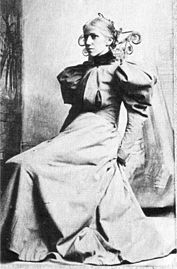Amelia Van Buren

Amelia C. Van Buren (* approx. 1856 in Detroit , Michigan ; † 1942 in Tryon , North Carolina ) was an American photographer best known for the painting Miss Amelia Van Buren , which Thomas Eakins made of her around 1891.
Student at the Pennsylvania Academy of the Fine Arts

Van Buren's parents both died before 1884 when she began studying at the Pennsylvania Academy of the Fine Arts . She had previously exhibited her art in Detroit for at least four years.
Her talent prompted Eakins to take care of her personally, which included teaching life drawing with male and female models , which was considered improper for female students at the time. In 1885/86 several former students of Eakins - especially Thomas Pollock Anshutz and Colin Campbell Cooper - allied to remove him from the academy. They turned to the Academy's Education Committee and made numerous allegations against Eakins. Among other things, they accused him of using female students, including Van Buren, as nude models. There was also great indignation that Eakins had taken off his pants to demonstrate the movement when Van Buren asked him about the movement of the pool. Eakins later emphasized the purely professional nature of this act. The committee led Eakins to believe that the complaint against him was brought by Van Buren, who had since moved to Detroit to recover from a nervous weakness . But this was not the case; she held Eakins in high esteem, defended him at every opportunity in the years that followed, and was proud to have works by him.
After her convalescence, Van Buren returned to Philadelphia and continued her studies with Eakins at the Art Students' League of Philadelphia. Even after that, Eakins and Van Buren were in close contact for years. Miss Amelia Van Buren was painted three or four years after his release from PAFA .
After the academy time
Little is known about Van Buren's life and work after completing her academy training; none of her paintings have survived.
She went with her classmate Eva Watson-Schütze a Boston marriage one. Both opened a studio and a gallery in Atlantic City New Jersey , but since Van Buren did not want to compromise on aesthetics for commercial reasons, she turned to photography . Both women were recognized artists who exhibited together at the Camera Club of Pittsburgh in 1899 , where Van Buren attracted attention for their portraits. According to her own statement, it was her goal to create portraits that “can stand alongside [those of] Sargent , Watts and the other masters”.
It is known that in 1900, when she sent some prints (including the "Woman in the Veil") to Frances Benjamin Johnston , she moved back to Detroit. Her portrait, painted by Eakins, was in her possession, presumably as a gift from the artist. In 1927 she sold it to the Phillips Memorial Gallery . At the time she was living in North Carolina .
In the early 1930s, the first Eakins biographer, Lloyd Goodrich, wrote to her, but received the reply that she had no special memories of Eakins. She spent her final years in an artist colony in Tryon , North Carolina , where she died in 1942.
Web links
Individual evidence
- ↑ Van Buren was born, according grave stone in 1854 ( Tryon Cemetery, Section 1. USGenWeb, archived from the original on September 7, 2010 , accessed August 24, 2010 . ), Census data from 1870 and 1900 say 1856 other sources in 1858 (Laurinda S. Dixon)
- ↑ a b c d e Henry Adams: Eakins revealed. The secret life of an American artist . Oxford University Press US, 2005, ISBN 0-19-515668-4 ( books.google.com ).
- ↑ Laurinda S. Dixon, Gabriel P. Weisberg: In sickness and in health: disease as metaphor in art and popular wisdom . University of Delaware Press, 2004, ISBN 0-87413-857-4 , pp. 124 ( books.google.com ).
- ↑ Darrel Sewell: Thomas Eakins . Yale University Press, 2001, ISBN 0-87633-143-6 , pp. 260 .
- ^ A b Sidney Kirkpatrick: The revenge of Thomas Eakins . Yale University Press, 2006, ISBN 0-300-10855-9 ( books.google.com ).
- ^ Martin W. Sandler: Against the Odds. Women Pioneers in the First Hundred Years of Photography . Rizzoli International Publications, 2002, ISBN 0-8478-2304-0 , pp. 61-62 .
- ↑ a b Naomi Rosenblum: A History of Women Photographers . Abbeville Press, 1994, ISBN 1-55859-761-1 , pp. 323 .
- ↑ George Cotkin: Reluctant modernism. American thought and culture, 1880-1900 . Rowman & Littlefield, 2004, ISBN 0-7425-3147-3 ( books.google.com ).
- ↑ Eakins in the Collection. The Phillips Collection, accessed August 22, 2010 .
- ↑ John Wilmerding: Thomas Eakins . Smithsonian Institution Press, 1993, ISBN 1-56098-313-2 , pp. 121 .
| personal data | |
|---|---|
| SURNAME | Buren, Amelia Van |
| ALTERNATIVE NAMES | Buren, Amelia C. Van |
| BRIEF DESCRIPTION | American photographer |
| DATE OF BIRTH | around 1856 |
| PLACE OF BIRTH | Detroit , Michigan |
| DATE OF DEATH | 1942 |

